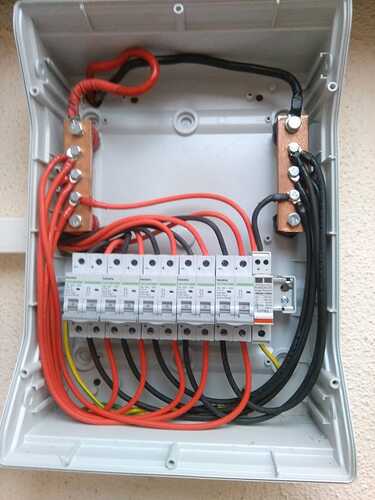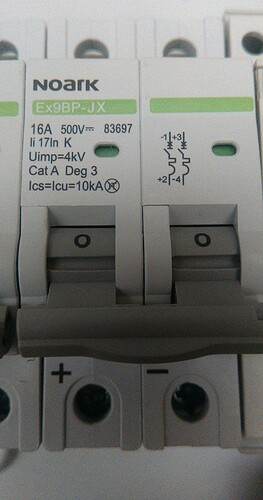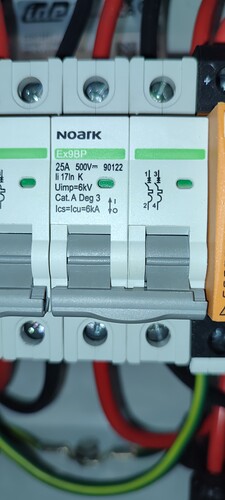Is it a SANS requirement to install DC circuit breakers in a solar db/combiner box or is a fuse by itself, ok
Regulations aside for the moment, then you can apply sense.
A fuse is guaranteed bidirectional, an MCB not. But to open/ pull a fuse on load is not a good thing.
( Scary, but not really dangerous, with pre-cautions, and so the cheapest option that will do the job)
So MCB is better for isolation and protection if it is non- directional, but it is more expensive.
An MCB is generally a more visual indication but, the hinged fuses come with LEDs nowadays.
I think regs call for fuses for 3 parallel strings or more, but you will need a point of isolation whether the regs require it or not.
Edit: And obviously everything operable from ground level.
Edit, edit: It is a controversial subject whether fuse protection on parallel strings is more trouble than it is worth, when the nuisance value is taken into account, but regs are regs, I suppose.
I do use an idolater switch, just wanted to know if the regulations require a circuit breaker in addition to a fuse
Isolator switches are rarely on load isolators. Which means you can switch yours at night. But at night you could pull fuses anyway, without a hassle.
So it is redundant.
MCBs have symbols that denote their usage. I have posted these symbols on this forum before.
Read up on these symbols, because the MCB housing may look the same, but the capability of the internals may be chalk and cheese.
Some MCBs are on load isolators and overload protection, some are either.
From what I recall, you need both fuses and isolators. In some cases if the inverter has an isolator that meets all the requirements (as well as mounting requirements), you don’t need an additional isolator in the DC combiner box.
So what I am trying to say is a fuse is a fuse.
( Time curves aside). Properly rated it can provide isolation and overload protection.
(Although, it may take the brave to use it as an on load isolator)
However, an MCB is not an MCB in the same sense.
It can be an off- load isolator, an on - load isolator, provide overload protection whilst being unsuitable for isolation, or provide on- load isolation and overload protection.
With DC mcbs you can throw directional capability into the mix.
You won’t know which until you know the symbols.
The higher the functionality the higher the price.
To be unrestricted in this application you require bi- directional overload protection and the ability to do on- load isolation.
This can be done by a fully capable mcb by itself, or a less capable mcb in combination with a fuse, ( or even another less capable mcb that fill in the blanks). The economic decision is yours, once the technical requirements are met.
You require the capability of on- load isolation and overload.
According to SANS, each string is considered a supply and needs a switch disconnector:
A switch disconnector is defined as:
While a fuse provides overcurrent protection (as required per 7.12.5), it is not a switch disconnector. You therefore need a DC breaker for each string, or an on-load isolator in combination with fuses.
Fuses are cheap, so in my installs I’ve been putting in both DC breakers and fuses.
Did post this before, here is what I did.
Was not cheap, more wires from the roof and all that, for I thought “Do it once, do it right and as conveniently for me as possible, and forget about it”.
Can switch each string off to test, under load, my main goal.
There is a difference between regs, manufacturer requirements, and common sense.
The regs do not require specifically a fuse or a breaker - they only require an overcurrent protection device, and they generally recommend a breaker for that purpose.
When used as a protection box (one string), then a single breaker is fine - it meets all the requirements for over current, isolation and disconnection.
When used for multiple strings, then it gets more interesting. Some manufacturers require overcurrent protection on each string. Some don’t. But I think it is always a good idea.
But fault currents in parallel strings could be in either direction. So, any protection device here must be bidirectional DC, which can get expensive and/or impossible to find.
So it makes sense to use fuses on the individual strings.
But then you still need overcurrent protection for the feed wire, and disconnection/isolation. While you could also use a fuse here, many holders are not rated for disconnect under load. So it becomes cheaper/easier to just use one isolation rated breaker on the output wire.
Things are a bit different in Aus. They jumped on the solar bandwagon early, and had many fires due to incorrect breaker installations on solar panels (polarised used where non-polarised required, or polarised installed backwards, etc). So they banned breakers entirely. (Although I have heard that they may have rolled this requirement back.)
Please don’t be offended. But IMO, that is a perfect example of what not to do.
A short in one string will take the full reverse current of all other strings combined. This will trip the breaker, but being a reverse current, it will just arc and start a fire.
Exactly this configuration was the cause of many fires in Australia, which is why it was banned there.
And there is no single point source disconnect as required in SANS regs…
None taken. We all learn here.
The thing is, not my idea, as I asked for a solution and was given this by a solar systems engineer, signed off, and all that.
NoArk breakers are damn good breakers, designed for purpose, not so?
Hold, wait a minute … breaker per string, switch them all off …
So what then if you have more than one MPPT? Multiple sources?
I have 250/85 and a 150/45 in the same combiner box now. Re-installed by a reputable solar installer.
No professional has ever commented that NoArk breakers are not “fit for purpose” for a combiner box.
There is nothing wrong with NoArk breakers. The problem is that those specific breakers are the polarised version (NoArk also makes non-polarised ones, which would have been fine).
One of the most likely failure scenarios is a short in one string (or blocking diode failure in partial shade conditions). Since all panels are connected in parallel, all current available from all parallel panels will flow into that one bad string.
This total current should be higher than the breaker rating, and it should trip. BUT polarised DC breakers can only break current in the forward direction (usually because they use a magnetic ark breaker instead of a wiper). When breaking in reverse, they can not extinguish the ark, and will very quickly start a fire.
Non-polarised breakers would not have this issue - when they trip (with current in either direction), they will safely break the ark and open the circuit.
As to single-point disconnects, that is open to interpretation. I would read it that each MPPT input is an energy source, and must have an isolator. It is also safer that way - any piece of equipment can be immediately isolated from an energy source.
EDIT: Got some expert opinions in, translated:
16a breaker per string - 5 strings.
Reverse current will be broken with ease, specifically for Victron setups.
In other words, No-Ark is a point of isolation AND protection, for reverse currents too.
I’m happy, my source is qualified. I trust his advice/opinion/design. ![]()
Thanks for the heads up though … best if this solution is specced properly by an expert, as other makes of inverters may not need it, be a overkill, or must be done differently.
I’m happy with my expert source feedback, that it is 100% fine the way it is done, for this system.
Closeup of the breaker:
For more detailed info:
https://www.noark-electric.eu/en/products/110086/
Slip a kitchen knife or a hacksaw blade next to the mcbs, no magnet, then bi - directional; magnet, then problem.
Get a different opinion. From that product web page:
110089 Miniature Circuit Breaker Ex9BP-JX(+) 2P C32
EAN: 8592765100894
General purpose DC Miniature Circuit Breakers Ex9BP-JX are designed for general direct current applications. Due to their polarity dependence it is necessary to respect the polarity of the current.
(my highlighting.)
That specific product will NOT interrupt a reverse failure.
But only at a significantly lower voltage than the rated voltage.
And that is exactly why these were banned in Australia. The general understanding, even among supposed experts, of the installation and operation of DC breakers tends to 0.
Many highly qualified electricians have made this mistake, and their customers have paid the price.
I am referring all you say onwards … waiting for replies.
A difficult position I’m in.
So I double-check everything said here, applicable to me, where it contradicts what others told me to do.
For I cannot, will not, try and think I know the first thing about this. Monkey see, monkey do.
But once all are in agreement, THEN I have a “Monkey Do This and This Only” picture see. ![]()
![]()
I’ll be back …
I do not have a combiner box but rather a protection box.
I have decided to look for the NoArk bidirectional MCB close-up photo
Based on the spec https://www.em.co.za/site/Catalogue%20PDFs/Catalogue%20Sections%20for%20Website/2022-23-B-Power%20distribution%20_%20protection.pdf One should use the Ex9BP for solar and not the JX series.
Correct:

vs

Slight change in the part number makes the difference between a protection device and a fire starter…





